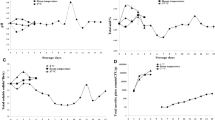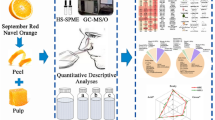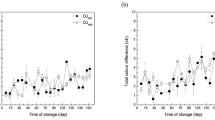Abstract
The effects of pasteurization and 4-month storage on the aroma profile of orange juices with pulp that were fully processed and packed in inert nitrogen atmosphere were investigated within the span of 2 years (2018 and 2019). Headspace solid-phase microextraction, gas chromatography-mass spectrometry, as well as gas chromatography coupled to flame ionization detection and olfactometry, were used for extraction, and subsequent analysis of the odour-active volatiles. Observed changes in their odour intensity, including the formation of some off-flavours such as methional, furaneol, 4-vinylguaiacol and guaiacol, were not significant to that extent to lead to an evident worsening in the overall flavour of juices. Thus, the use of nitrogen atmosphere proved its ability to protect the organoleptic quality of juice from undesirable changes caused by oxidative load or acid-catalysed reactions. Aroma profiles of fresh juices were considerably influenced by diverse climatic conditions, and different seasons of orange harvest in monitored years. Pasteurization and storage had lesser impact on the volatiles in 2018 as in 2019, probably due to the inter-annual variability in such parameters of juices as content of pulp and pH.

Similar content being viewed by others
References
Arena E, Guarrera N, Campisi S, Nicolosi Asmundo C (2006) Comparison of odour active compounds detected by gas-chromatography–olfactometry between hand-squeezed juices from different orange varieties. Food Chem 98:59–63. https://doi.org/10.1016/j.foodchem.2005.04.035
Averbeck M, Schieberle P (2009) Characterization of the key aroma compounds in a freshly reconstituted orange juice from concentrate. Euro Food Res Technol 229:611–622. https://doi.org/10.1007/s00217-009-1082-4
Averbeck M, Schieberle P (2011) Influence of different storage conditions on changes in the key aroma compounds of orange juice reconstituted from concentrate. Eur Food Res Technol 232(2011):129–142. https://doi.org/10.1007/s00217-0101366-8
Bacigalupi C, Lemaistre MH, Boutroy N et al (2013) Changes in nutritional and sensory properties of orange juice packed in PET bottles: an experimental and modelling approach. Food Chem 141:3827–3836. https://doi.org/10.1016/j.foodchem.2013.06.076
Bazemore R, Goodner K, Rouseff R (1999) Volatiles from unpasteurized and excessively heated orange juice analyzed with solid phase microextraction and GC-olfactometry. J Food Sci 64:800–803. https://doi.org/10.1111/j.1365-2621.1999.tb15915.x
Bazemore R, Rouseff R, Naim M (2003) Linalool in orange juice: origin and thermal stability. J Agric Food Chem 51:196–199. https://doi.org/10.1021/jf0257291
Berlinet C, Ducruet V, Brillouet JM et al (2005) Evolution of aroma compounds from orange juice stored in polyethylene terephthalate. Food Addit Contam 22:185–195. https://doi.org/10.1080/02652030500037860
Berlinet C, Brat P, Brillouet JM, Ducruet V (2006) Ascorbic acid, aroma compounds and browning of orange juice related to PET packaging materials and pH. J Sci Food Agric 86:2206–2212. https://doi.org/10.1002/jsfa.2597
Bezman Y, Rouseff RL, Naim M (2001) 2-Methyl-3-furanthiol and methional are possible off-flavors in stored orange juice: aroma similarity, NIF/SNIF GC-O, and GC analyses. J Agric Food Chem 49:5425–5432. https://doi.org/10.1021/jf010724+
Bi S, Sun S, Lao F et al (2020) Gas chromatography-mass spectrometry combined with multivariate data analysis as a tool for differentiating between processed orange juice samples on the basis of their volatile markers. Food Chem 311:125913. https://doi.org/10.1016/j.foodchem.2019.125913
Bianchi F, Careri M, Mangia A et al (2010) Characterization of the volatile profile of orange juice contaminated with Alicyclobacillus acidoterrestris. Food Chem 123:653–658. https://doi.org/10.1016/j.foodchem.2010.05.023
Blank I, Schieberle P (1993) Analysis of the seasoning-like flavour substances of a commercial lovage extract (Levisticum officinale Koch). Flavour Fragr J 8:191–193. https://doi.org/10.1002/ffj.2730080405
Blank I, Fischer KH, Grosch W (1989) Intensive neutral odorants of linden honey. Differences from honeys of other botanical origin. Z Lebensm Unters Forsch 189:426–433
Farnworth ER, Lagacé M, Couture R et al (2001) Thermal processing, storage conditions, and the composition and physical properties of orange juice. Food Res Int 34:25–30. https://doi.org/10.1016/S09639969(00)00124-1
Gocmen D, Elston A, Williams T, Parish M (2005) Identification of medicinal off-flavours generated by Alicyclobacillus species in orange juice using GC-olfactometry and GC–MS. Lett Appl Microbiol 40:172–177. https://doi.org/10.1111/j.1472-765X.2004.01636.x
Guth H, Grosch W (1991) A comparative study of the potent odorants of different virgin olive oils. Fett Wiss Technol 93:335–339
Haleva-Toledo E, Naim M, Zehavi U, Rouseff RL (1997) 4-Hydroxy-2,5-dimethyl-3(2H)-furanone formation in buffers and model solutions of citrus juice. J Agric Food Chem 45:1314–1319. https://doi.org/10.1021/jf960724n
Janáčová A, Sádecká J, Kohajdová Z, Špánik I (2008) The identification of aroma-active compounds in Slovak brandies using GC-sniffing, GC-MS and sensory evaluation. Chromatographia 67:S113–S121. https://doi.org/10.1365/s10337-0080635-1
Jordán MJ, Goodner KL, Laencina J (2003) Deaeration and pasteurization effects on the orange juice aromatic fraction. LWT – Food Sci Technol 36:391–396. https://doi.org/10.1016/S0023-6438(03)00041-0
Kim MK, Jang HW, Lee KG (2018) Sensory and instrumental volatile flavour analysis of commercial orange juice prepared by different processing methods. Food Chem 267:217–222. https://doi.org/10.1016/j.foodchem.2017.10.129
Kopuncová M, Sádecká J, Kolek E et al (2018) Impact of inert gas atmosphere application on the complex profile of commercial orange juice volatiles during four-month storage. J Food Nutr Res 57:373–383
Mastello RB, Capobiango M, Chin ST et al (2015) Identification of odour-active compounds of pasteurised orange juice using multidimensional gas chromatography techniques. Food Res Int 75:281–286. https://doi.org/10.1016/j.foodres.2015.06.014
Mastello RB, Janzantti NS, Bisconsin-Júnior A, Monteiro M (2018) Impact of HHP processing on volatile profile and sensory acceptance of Pȇra-Rio orange juice. Innov Food Sci Emerg Technol 45:106–114. https://doi.org/10.1016/j.ifset.2017.10.008
Moshonas MG, Shaw PE (1989) Changes in composition of volatile components in aseptically packaged orange juice during storage. J Agric Food Chem 37:157–161. https://doi.org/10.1021/jf00085a037
Perez-Cacho PR, Rouseff R (2008) Processing and storage effects on orange juice aroma: a review. J Agric Food Chem 56:9785–9796. https://doi.org/10.1021/jf801244j
Perez-Cacho PR, Danyluk MD, Rouseff R (2011) GC-MS quantification and sensory thresholds of guaiacol in orange juice and its correlation with Alicyclobacillus spp. Food Chem 129:45–50. https://doi.org/10.1016/j.foodchem.2011.04.014
Petersen MA, Tønder D, Pool L (1998) Comparison of normal and accelerated storage of commercial orange juice—changes in flavour and content of volatile compounds. Food Qual Prefer 9:43–51. https://doi.org/10.1016/S09503293(97)00027-X
Sádecká J, Polovka M, Kolek E et al (2014) Orange juice with pulp: impact of pasteurization and storage on flavour, polyphenols, ascorbic acid and antioxidant activity. J Food Nutr Res 53:371–388
Tønder D, Petersen MA, Poll L, Olsen CE (1998) Discrimination between freshly made and stored reconstituted orange juice using GC odour profiling and aroma values. Food Chem 61:223–229. https://doi.org/10.1016/S0308-8146(97)00097-6
Van den Dool H, Kratz P (1963) A generalization of the retention index system including gas-liquid partition chromatography. J Chromatogr A 11:463–471. https://doi.org/10.1016/S00219673(01)80947-X
Vervoort L, Grauwet T, Kebede BT et al (2012) Headspace fingerprinting as an untargeted approach to compare novel and traditional processing technologies: a case-study on orange juice pasteurisation. Food Chem 134:2303–2312. https://doi.org/10.1016/j.foodchem.2012.03.096
Wibowo S, Grauwet T, Kebede BT et al (2015) Study of chemical changes in pasteurised orange juice during shelf-life: a fingerprinting-kinetics evaluation of the volatile fraction. Food Res Int 75:295–303
Acknowledgements
This study was supported by research projects “Quality and authenticity of fruit juices—study of relationships between the origin of feedstock, processing technology and quality of fruit juices” (APVV-150023). This publication was supported by the Operational program Integrated Infrastructure within the project: Demand-driven research for the sustainable and innovative foods, Drive4SIFood, 313011V336, cofinanced by the European Regional Development Fund.
Author information
Authors and Affiliations
Corresponding author
Ethics declarations
Conflict of interest
The authors have no competing interests to declare that are relevant to the content of this article.
Additional information
Publisher's Note
Springer Nature remains neutral with regard to jurisdictional claims in published maps and institutional affiliations.
Ján Durec: Production premises—McCarter Ltd., Budovateľská 1247/7, 92901 Dunajská Streda, Slovak Republic.
Rights and permissions
About this article
Cite this article
Kopuncová, M., Sádecká, J., Kolek, E. et al. Aroma stability and sensory aspects of commercially produced orange juice: gas chromatography–olfactometry study. Chem. Pap. 76, 4941–4953 (2022). https://doi.org/10.1007/s11696-022-02198-w
Received:
Accepted:
Published:
Issue Date:
DOI: https://doi.org/10.1007/s11696-022-02198-w




